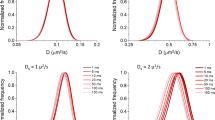Abstract
A system s{ X(t)} = {X 1(t),X 2(t),..., X N(t)} of N interacting time reversible continuous time Markov chains is considered. The state space of each of the processes {X i(t)} (i = 1, 2,...,N) is partitioned into two aggregates. Interaction between the processes {X i(t)},{X 2(t)},...,{X N(t)} is introduced by allowing the transition rates of an individual process at time t to depend on the configuration of aggregates occupied by the other N - 1 processes at that time. The motivation for this work comes from ion channel modeling, where {(X}(t)} describes the gating mechanisms of N channels and the partitioning of the state space of {X i(t)} correspond to whether the channel is conducting or not. Let S(t) denote the number of conducting channels at time t. For a time-reversible class of such processes, expressions are derived for the mean and probability density function of the sojourns of {S(t)} at its different levels when {X(t)} is in equilibrium. Particular attention is paid to the situation when the N channels are located on a circle with nearest neighbor interaction. Necessary and sufficient conditions for a general co-operative multiple channel system to be time reversible are derived.
Similar content being viewed by others
References
F. G. Ball, S. S. Davies, and M. S. P. Sansom, “A sequential allosteric model for receptor-gated ion channels:modeling of single channel properties,” J. Physiol. vol. 467, pp. 358, 1993.
F. G. Ball and R. K. Milne, “Simple point process methods, with applications to aggregated processes and ion channel modeling,” In preparation. 1999.
F. G. Ball, R. K. Milne, and G. F. Yeo, “Continuous-time Markov chains in a random environment, with application to ion channel modeling,” Adv. Appl. Prob. vol. 26, pp. 919-946, 1994.
F. G. Ball, R. K. Milne, I. D. Tame, and G. F. Yeo, “Superposition of interacting aggregated continuous-time Markov chains,” Adv. Appl. Prob. vol. 29, pp. 56-91, 1997.
F. G. Ball and J. A. Rice, “Stochastic models for ion channels: introduction and bibliography,” Math. Biosci. vol. 112, pp. 189-206, 1992.
F. G. Ball and G. F. Yeo, Spatially interacting aggregated continuous time Markov chains and their superposition properties, Research report no. 99-01, Nottingham Statistics Group, University of Nottingham, 1999.
D. Colquhoun and A. G. Hawkes, “Relaxation and fluctuations of membrane currents that ¯ow through drug operated channels,” Proc. R. Soc. Lond. B vol. 199, pp. 231-262, 1977.
A. R. Dabrowski and D. McDonald, “Statistical analysis of multiple ion channel data,” Ann. Statist. vol. 20, pp. 1180-1202, 1992.
A. R. Dabrowski, D. McDonald, and U. Rösler, “Renewal properties of ion channels,” Ann. Statist. vol. 18, pp. 1091-1115, 1990.
S. Draber, R. Schultze, and U.-P. Hansen, “Cooperative behavior of K+ channels in the tonoplast of Chara corallina,” Biophys. J. vol. 65, pp. 1553-1559, 1993.
D. Fredkin and J. A. Rice, “On the superposition of currents from ion channels,” Phil. Trans. R. Soc. Lond. B vol. 334, pp. 347-356, 1991.
F. Kelly, Reversibility and Stochastic Networks, Wiley: Chichester UK, 1979.
A. M. Keleshian, G. F. Yeo, R. O. Edeson, and B. W. Madsen, “Superposition properties of interacting ion channels,” Biophys. J. vol. 67, pp. 634-640, 1994.
A. M. Keleshian, R. O. Edeson, G.-J. Liu, and B. W. Madsen, “Evidence for positive cooperativity between nicotinic acetylcholine receptors in patch clamp records,” Biophys. J. vol. 78, pp. 1-12, 2000.
S. Kijima and H. Kijima, “Statistical analysis of channel current from a membrane patch. I. Some stochastic properties of ion channels or molecular systems in equilibrium,” J. Theor. Biol. vol. 128, pp. 423-434, 1987a.
S. Kijima and H. Kijima, “Statistical analysis of channel current from a membrane patch. II. A stochastic theory of a multi-channel system in the steady-state,” J. Theor. Biol. vol. 128, pp. 435-455, 1987b.
P. Läuger, “Conformational transitions of ionic channels”. In Single-Channel Recording, 2nd edition, ed. B. Sakmann and E. Neher, Plenum Press: New York, 1995, pp. 651-662.
K. Manivannan, R. T. Mathias, and E. Gudowska-Novak, “Description of interacting channel gating using a stochastic Markovian model,” Bull. Math. Biol. vol. 58, pp. 141-174, 1996.
N. Nayeem, T. P. Green, I. L. Martin, and E. A. Barnard, “Quaternary structure of the native GABAA receptor determined by electron microscopic image analysis,” J. Neurochem. vol. 62, pp. 815-818, 1994.
J. Riordan, An Introduction to Combinatorial Analysis, Wiley: New York, 1965.
B. Sakmann and E. Neher, eds. Single-Channel Recording, Plenum Press: New York, 1995.
G. F. Yeo, R. O. Edeson, R. K. Milne, and B.W. Madsen, “Superposition of independent ion channels,” Proc. R. Soc. Lond. B vol. 238, pp. 155-170, 1989.
E. Yeramian, A. Trautmann, and P. Claverie, “Acetylcholine receptors are not functionally independent,” Biophys. J. vol. 50, pp. 253-263, 1986.
Author information
Authors and Affiliations
Rights and permissions
About this article
Cite this article
Ball, F., Yeo, G. Superposition of Spatially Interacting Aggregated Continuous Time Markov Chains. Methodology and Computing in Applied Probability 2, 93–115 (2000). https://doi.org/10.1023/A:1010011418887
Issue Date:
DOI: https://doi.org/10.1023/A:1010011418887



